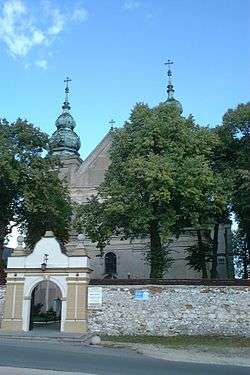Mstów, Silesian Voivodeship
Mstów [mstuf] (Yiddish: Amstov) is a village (town in 1279 - 1870) in Częstochowa County, Silesian Voivodeship, in southern Poland. It is the seat of the gmina (administrative district) called Gmina Mstów.[1] It lies approximately 13 kilometres (8 mi) east of Częstochowa and 68 km (42 mi) north of the regional capital Katowice. Mstów lies on the Warta river, in western part of historic province of Lesser Poland. The village has a population of 1,704, and in early days of Polish history, it was the regional center of an opole (the word opole comes from Slavic language, and means basic territorial unit of a tribe). The village has a population of 1,704.
Mstów | |
|---|---|
Village | |
 Monastery | |
 Mstów | |
| Coordinates: 50°49′40″N 19°17′14″E | |
| Country | |
| Voivodeship | Silesian |
| County | Częstochowa County |
| Gmina | Mstów |
| Population | 1,704 |
Mstów was first mentioned as Mstowo in 1193, when it belonged to the congregation of Canons Regular of the Lateran from Wrocław. Sometime in the early 13th century, a large monastery was built here. It burned in a great fire of 1566, then the complex was rebuilt and destroyed several times. More destruction came during World War I, when several German-Russian skirmishes took place here in early stages of the conflict. During those fights, the towers and defensive walls of the ancient church were destroyed, as well as the roof of the nave. The complex was gradually rebuilt in the 1920s and 1930s.
In the Kingdom of Poland and the Polish-Lithuanian Commonwealth, fields around the monastery were used by Lesser Poland’s szlachta for its sejmiks. Among notable guests of Mstów, there was Queen Bona Sforza. Mstów, whose name probably comes from an ancient Slavic given name Msta, received its town charter in 1279, from Prince of Kraków Bolesław V the Chaste. Several years before that event, in 1212, a council of Polish bishops took place here, and among its participants was Wincenty Kadłubek. The very fact that a meeting like this was organized in Mstów means that it had already been an important location, and it had the monastery complex ready to host the bishops. In the Middle Ages Mstów was located along a very important merchant route from Kraków to Greater Poland. The town had a toll bridge on the Warta river, and merchants stayed here on the way to their destinations. As a result, a fair was established in Mstów some time in the first half of the 12th century. In the course of time, to guard the route, wooden strongholds were erected along the road. In 1220, the Bishop of Kraków, Iwo Odrowąż, founded a defensive Church here. Mstów emerged as a main urban center of northwestern Lesser Poland, and in the 13th century, the town was destroyed several times by the Mongols (see Mongol invasion of Poland). In 1260, the Mongols burned the monastery; their last raid took place in 1266.
After Mstów had received its town charter, a market square was designed, with rectangular streets, whose shape has not been changed. The town had its local government, and despite widespread destruction following the raid of King Wenceslaus II of Bohemia (1292), it quickly recovered, with several artisan guilds being active here. In 1327, Mstów was visited by King Władysław Łokietek, and following this visit, for unknown reasons the post of a local starosta was transferred to the town of Olsztyn, where a castle was built. During the Polish–Lithuanian–Teutonic War, the Mstów monastery was a gathering point for royal troops. In the 15th century, Mstów had 105 houses, and remained an important location, where in 1474 Polish troops gathered under King Kazimierz Jagiellończyk, for a Silesian campaign against King of Hungary Matthias Corvinus. Mstów had its coat of arms and a seal, with an inscription SI - Gillum - CIYITTATIS - MSTHUOW (1564). At that time, and until 1795, Mstów belonged to Lelów County of Lesser Poland’s Kraków Voivodeship.
In the 17th century the merchant route lost its importance, which resulted in Mstów's decline to the benefit of nearby Częstochowa. In 1655 (see the Deluge), Swedes captured the town and the monastery, destroying it completely. Mstów lost 50% of inhabitants, and the destruction was so widespread that the town never recovered. In 1697, a Baroque synagogue was built, as the number of Jews grew. Mstów was destroyed in 1709 by Russian troops during the Great Northern War, and in the third partition of Poland, the town was cut in half, along the Warta river. The district on the right bank of the river became part of Prussian New Silesia, and the rest was captured by Austria. The Prussians destroyed the monastery, and furthermore, in 1801 Mstów was burned in a fire. In 1815 the town became part of Russian-controlled Congress Poland, and by the 1850s, one-third of its population was Jewish. Polish residents actively supported the January Uprising, for which Mstów lost its town charter in 1870. After the great fire of 1879, Mstów lost many residents, who moved to the quickly developing industrial center of Częstochowa. In 1933, already in Kielce Voivodeship, it had 284 houses and 2,129 inhabitants. The village suffered further losses in World War II. Its historic buildings were destroyed by the Germans, and its Jewish population was decimated in the Holocaust.
In 1970 Mstów had 314 houses and the population of 1,676, most of which were farmers. In 1993 the local council undertook an initiative aimed at recovering the town charter, but it failed.
Notable people
- Efraim Tzvi Einhorn (1851- 1901), Rabbi and Rosh Yeshiva of the Town
- Dov Berish Einhorn(1877 - 1942), Rabbi and Rosh Yeshiva of the Town